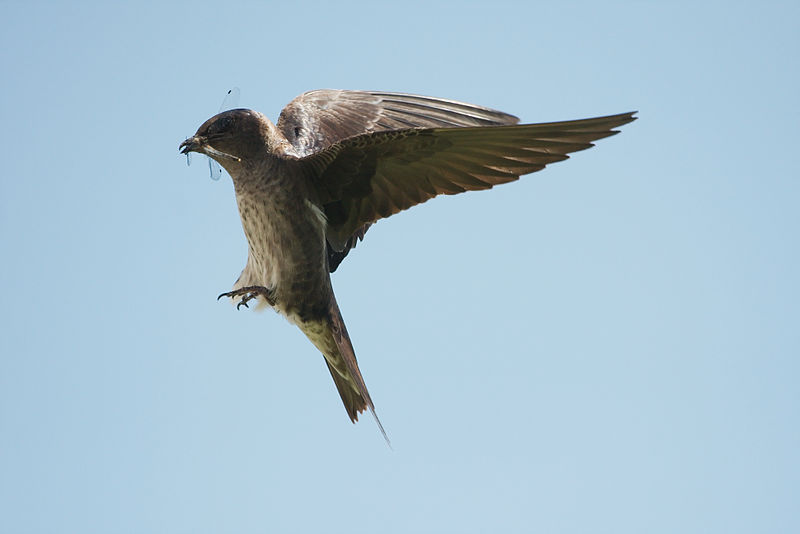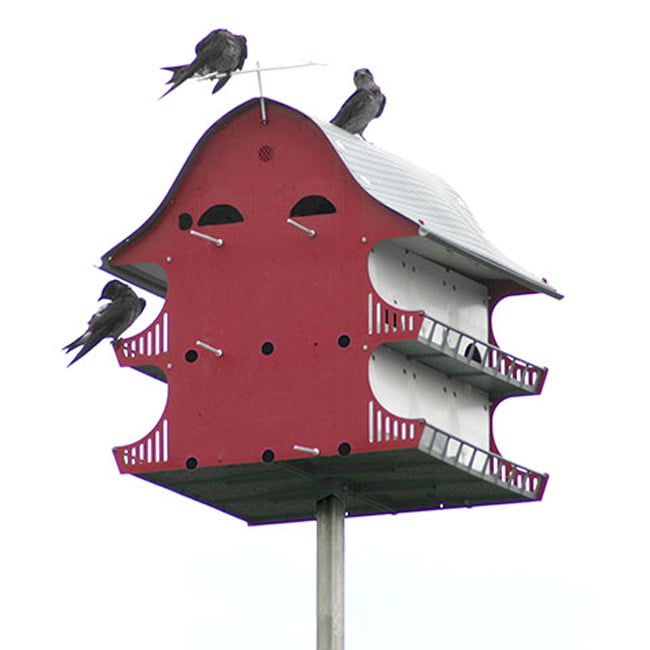
Purple Martins are beautiful iridescent birds that have a long and storied history with humans. Native Americans used to hollow gourds and put them up for Purple Martins to nest in. However, since then, Purple Martin populations have suffered a setback with the introduction of European Starlings and House Sparrows.
Their numbers dipped over the years because these more aggressive invasive species have taken over their nesting places. Still, Purple Martins’ acrobatic aerial displays, shiny feathers and trust of humans make them a desirable backyard bird.
Here’s how to encourage these birds to come into your yard.
Purple Martin houses
One reason why Purple Martins are so coveted and beloved is that they are very social creatures who live in fairly large colonies. Because there is a lack of good nesting sites in many places, Purple Martin houses bring in large groups of the birds.

These typically look like miniature houses with a few dozen holes in it or a rack of hollowed gourds attached to a pole.
Sometimes a few dozens pairs can be attracted to these houses, depending on how large they are.Pick the perfect location for the house
Getting the Purple Martin house is the first step, but putting it in the right location will determine whether they will actually come.

i According to Bird Man Mel, at least 40 feet around the house should be free of any trees or structures because the birds like to freely soar to and from the site. You should also have it within 100 feet of your residence because Purple Martins feel safer and more comfortable around humans.
Make sure it’s safe and free of predators
The houses should be placed in open areas where predators cannot lurk. While you might think cats are a Purple Martin’s biggest worry, it’s actually starlings and sparrows. You want to make sure that none of these invasive species take over the Purple Martin houses. Another danger to these birds is nest parasites, so you should check occasionally to make sure they aren’t infesting your houses.
Food and water
Unlike other birds that will utilize bird feeders and birdbaths, Purple Martins prefer live food and natural water. They are aerial insectivores, which means they really only eat flying bugs. You can encourage more flying bugs to be on your property by not using insecticide, but it’s not as simple as just putting out food at your feeder.
Similarly, they don’t like birdbaths. Instead, they prefer drinking from and bathing in large ponds, so it’s an asset if you have one on or near your property.
What to do if your Purple Martin house remains empty
Since these birds are very social and love being around each other, a lot of times when you don’t see a group, you won’t see any. You can “trick” the birds into thinking your house is being occupied by other Purple Martins by setting up one or two decoys. Another thing you can do is play the distinctive song of Purple Martins in the morning to lure in those that might be nearby.
By following these simple steps, you can have these birds soaring around your property in no time.



3 Comments
Again I listen to the experts. Which resulted in no martins. Last year the expert said not to open the nest boxes until weeks after the first birds showed up. The came left and never came back. This year another expert said put some nesting material in the boxes to attract the females. They came and looked. They just stuck their heads in and left. 2 years before, I had 3 pairs and babies. So as far as I am concerned the experts should keep their advice to themselves. Stop ruining other people’s season’s. I am tired of the cost a d disappointed. My nests are coming down a d will given to my friend.
That’s really great Marjorie. Thanks for sharing!
Growing up in Florida my Mother used to love purple martins. It was amazing how the martins would
smuch together and just fill the telephone wires with hundreds of birds. Driving in the back roads of Washington State I came across a huge collection of birds on the wires. My first thought was they had to be purple martins. I didnt have my binoculars, but it brought back happy memories of my Mom love of birds.